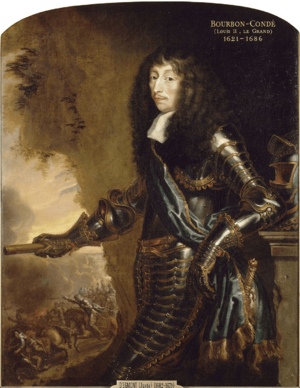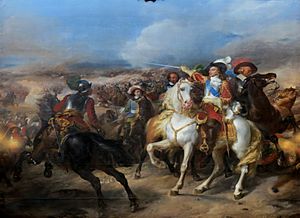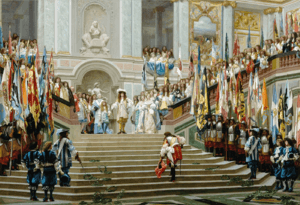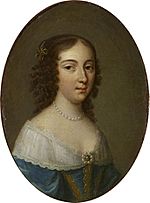Louis, Grand Condé facts for kids
Quick facts for kids Louis de Bourbon |
|
|---|---|
| Le Grand Condé | |

Portrait by Justus van Egmont
|
|
| Prince of Condé | |
| Tenure | 26 December 1646 – 11 December 1686 |
| Predecessor | Henri |
| Successor | Henri Jules |
| Born | 8 September 1621 Paris, France |
| Died | 11 December 1686 (aged 65) Palace of Fontainebleau, France |
| Burial | Église at Valléry, France |
| Spouse | Claire Clémence de Maillé |
| Issue Detail |
Henri Jules, Prince of Condé Louis, Duke of Bourbon |
| House | Bourbon (Condé branch) |
| Father | Henri, Prince of Condé |
| Mother | Charlotte Marguerite de Montmorency |
| Religion | Roman Catholicism |
| Signature | |
Louis de Bourbon, Prince of Condé (born September 8, 1621 – died December 11, 1686) was a famous French general. People called him the Great Condé (French: Le Grand Condé) because of his amazing military victories. He was a leading member of the Condé family, part of the House of Bourbon. Louis was one of the most important generals for Louis XIV, the King of France.
Condé is especially known for his wins during the Thirty Years' War. A big victory was at the Battle of Rocroi. He also led campaigns against a group of countries called the Grand Alliance in the Franco-Dutch War. For a time, he rebelled against King Louis XIV. This rebellion was called the Fronde, and it led to him being sent away from France until 1659.
Contents
A Young Prince's Life
Louis was born in Paris, France. His father was Henri II de Bourbon, Prince of Condé. His mother was Charlotte Marguerite de Montmorency. From birth, Louis was given the title of Duke of Enghien. His father was a distant cousin of King Henry IV. His mother came from a very important French noble family.
Condé's father made sure he got a good education. Louis studied history, law, and mathematics for six years. He went to a Jesuit school in Bourges. After that, he attended the Royal Academy in Paris. When he was just seventeen, he even governed the region of Burgundy.

Before he joined the army in 1640, his father arranged his marriage. He was to marry Claire-Clémence de Maillé-Brézé. She was the niece of Cardinal Richelieu, a very powerful man. Louis was only thirteen when he was forced to marry her. They had three children together.
As a young soldier, Enghien showed great skill. He helped in the siege of Arras. He also gained the favor of Cardinal Richelieu. He was with the Cardinal during a plot called Cinq Mars. Later, he fought in the Siege of Perpignan (1642).
Military Victories in the Thirty Years' War

In 1643, Enghien was put in charge of the army fighting Spain in northern France. He faced Francisco de Melo and the Spanish tercios. These Spanish soldiers were known as the toughest in Europe. At the Battle of Rocroi, Enghien planned and led a huge victory. This win was very important for France.
After many successes, Enghien returned to Paris as a hero. In 1644, he was sent to Germany to help Turenne. Turenne's army was in trouble. Enghien took command of the entire army there.
The Battle of Freiburg was a very tough fight. But after this, many enemy fortresses surrendered to the Duke. Enghien spent his winters in Paris, enjoying city life. The summer of 1645 started with a French defeat. Turenne was beaten by Franz von Mercy at Mergentheim. But Enghien turned things around at the Nördlingen. In this battle, Mercy was killed, and Enghien himself was badly wounded. Capturing Philippsburg was another big success that year.
In 1646, Enghien served in Flanders under Gaston, Duke of Orléans. When Orléans went back to Paris, Enghien stayed in command. He then captured the important city of Dunkirk on October 11.
The Fronde Rebellion

In 1646, Enghien became the 'Prince of Condé' after his father died. He was a great military leader. He also had a high noble status and was very rich. This made Anne of Austria, who was ruling for the young Louis XIV, and her chief minister, Mazarin, worried. Condé owned huge lands, including Burgundy.
To get Condé away from Paris, Mazarin sent him to fight in a revolt in Catalonia. This was called the Reapers' War. It was a complicated fight between Spain, France, and local people. Condé couldn't achieve much there. But when Spain started winning in the Low Countries, he was called back. He then won a big victory at Lens in August 1648.
Soon, French nobles started a rebellion against new taxes. This was called the Fronde. Condé was asked by Anne of Austria to help. He quickly put down the rebellion in Paris. This part of the Fronde ended in March 1649.
But Condé himself then rebelled against the king's government. This started a more serious part of the Fronde. In January 1650, he was arrested along with his brother. They were put in prison. Other nobles demanded their freedom. Condé was released in February 1651.
The royal army, led by Turenne, defeated Condé at the Battle of the Faubourg St Antoine in July 1652. This battle ended the Fronde as a major threat. Condé escaped only because a duchess persuaded the people of Paris to open the city gates for him. In September, he and some loyal followers joined Spain.
Condé fought for Spain against France. He won against Turenne at Valenciennes in 1656. But he lost at the Battle of the Dunes in June 1658. This led to the Treaty of the Pyrenees in 1659. Condé was pardoned by King Louis XIV and got his titles back. But his power as an independent prince was now gone.
Return to Royal Favor

Condé became a loyal supporter of King Louis XIV. He lived a quiet life at the Château de Chantilly. This estate was inherited from his uncle. At Chantilly, he gathered many famous writers and thinkers. These included Molière, Racine, and La Fontaine.
In 1668, Condé's quiet retirement ended. During the War of Devolution (1666-1667), he suggested a plan to capture Franche-Comté. He was given the job to carry out this plan, and he did it successfully. He was now fully back in the good graces of King Louis XIV.
With Turenne, he became a main French commander in the 1672 campaign against the Dutch. He was badly wounded while crossing the Rhine River. After this, he commanded the army in Alsace. In 1673, he fought again in the Low Countries.
In 1674, he fought his last big battle, the Battle of Seneffe, against William III of Orange. This battle was one of the hardest of the century. Condé showed the same bravery as when he was young. Three horses were killed under him during the fight. His very last campaign was in 1675 on the Rhine. He took command after Turenne was killed. With careful planning, he stopped the invasion by the Imperial army.
After this last campaign, Condé returned to Chantilly. He was tired from his efforts and suffered from gout. He spent his last eleven years living peacefully there. Towards the end of his life, Condé became very religious.
In 1685, his only surviving grandson married a daughter of King Louis XIV. In 1686, this granddaughter-in-law got smallpox. Condé helped care for her. He died at Fontainebleau on November 11, 1686, at age sixty-five. He was buried at Vallery, where other Princes of Condé rest.
Family and Children
Louis married Claire Clémence de Maillé in Paris in February 1641. The wedding was held at the Palais Royal. King Louis XIII of France, Anne of Austria, and Gaston of France were all there. Their children were:
- Henri Jules de Bourbon, Duke of Enghien (born July 29, 1643, Paris – died April 1, 1709, Paris). He later became Prince of Condé. He married Princess Anne of the Palatinate and had children.
- Louis de Bourbon, Duke of Bourbon (born September 20, 1652, Bordeaux – died April 11, 1653, Bordeaux). He died as a baby.
- X de Bourbon, Mademoiselle de Bourbon (born 1657, Breda – died September 28, 1660, Paris). She died as a child.
Condé's Legacy

Condé was a brilliant military leader. He could plan long wars and make quick decisions in battle. He was also very determined, even when his soldiers faced heavy losses. Because of this, he is compared to the greatest generals of his time. When the Grand Condé died, King Louis XIV said he had lost "the greatest man in my kingdom."
In 1643, his victory at the Battle of Rocroi made him a great general and a hero in France. He helped France achieve a good peace in the Thirty Years' War.
During the Fronde rebellion, he was first on the side of the king's minister. But he later became a leader of the nobles who rebelled. After the Fronde was defeated, he joined the Spanish army. He led their armies against France. He returned to France only after a peace treaty in 1659. But he soon received military commands again.
Condé conquered the Franche-Comté region during the War of Devolution. He also led French armies in the Franco-Dutch War with Turenne. His last campaign was in 1675. He took command after Turenne was killed. He successfully stopped an invasion by an enemy army.
Condé is seen as an excellent tactician and a great strategist. He is one of the greatest French generals ever. His masterpiece, the Battle of Rocroi, is still studied by military students today.
His family line includes the current people who claim to be the rightful kings of France and Italy. It also includes the kings of Spain and Belgium.
He was played by actor Julian Glover in the movie Vatel.
|
|
Louis, Grand Condé
Cadet branch of the House of Bourbon
Born: 8 September 1621 Died: 11 November 1686 |
||
| French nobility | ||
|---|---|---|
| Preceded by Henri de Bourbon |
Prince of Condé 26 December 1646 – 11 November 1686 |
Succeeded by Henri Jules de Bourbon |
See also
 In Spanish: Luis II de Borbón-Condé para niños
In Spanish: Luis II de Borbón-Condé para niños




